There’s no denying that what Tacoma is doing around the Foss Waterway and their downtown is impressive, especially for boaters. The upgraded marinas, new facilities and revitalized downtown make Tacoma a real cruising destination.
As it turns out, one of the greatest maritime assets on the Waterway isn’t commercial, it’s non-profit. Nonprofit? Yep, as in getting kids on the water.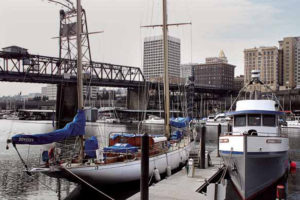
The Tacoma Youth Marine Center (TYMC), based at the old Totem boat yard, was founded back in 1992 by some energetic boaters who wanted to have a means of supporting the Sea Scouts. The mission expanded, as missions often do, and the Center is quickly becoming a multifaceted regional center to get young boaters on the water.
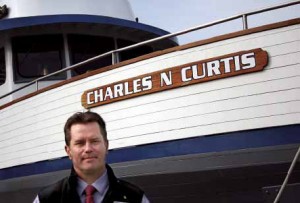
Malcolm Russell
The expanded mission can be a little confusing, something Executive Director Malcolm Russell would like to clear up. The TYMC is there to support and facilitate all organizations providing youth programs. It’s principle beneficiary is the Sea Scouts (the marine arm of the Boy Scouts of America).
So, while the Sea Scouts calls the facility home, so does the Tacoma Metro Park’s Sails & Trails day-camp and sailing program. In all likelihood, a yacht club or two looking to develop its sailing instruction program will look to partner with the TYMC.
“That’s really the strength of both the Sea Scouts and what we’re doing with the TYMC,” Russell explains. “Kids from all walks of life get to operate these boats together. And with the emphasis we put on growth and responsibility, it’s a very healthy environment.”
The other part of the confusion resides with the commercial entities that are still in operation and support the TYMC. In fact, those companies are really enabling the TYMC to carry on with its ambitious plans. Commencement Bay Marine Services is a modest boatyard, store and repair shop.
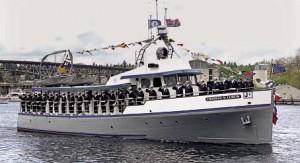
The Charles N. Curtis
The yard’s 20-ton lift is a tremendous feature that youth organizations around the area might be able to take advantage of. There’s a gas dock, the Tacoma Fuel Dock, that’s been there for decades and still has a loyal clientele including many commercial fishing and government vessels. Some moorage space is currently rented out to a boat dealer, but could become available should a need for additional program moorage space arise. Profits from all the commercial arms are directed back into the TYMC for its programs.
The most important gem in the operation might well be the 35,000 sq.ft. former boatbuilding shed. The building that once saw production of hundreds of commercial vessels is now a base of regional maritime programs and the facility operations.
More importantly, the commercial storage part of it is gradually giving way to more and more youth program gear. A small fleet of Walker Bay sailing dinghies and a vertical quiver of kayaks take up one corner. A loft on one side is all Sea Scouts gear, and the loft on the other side is for curing hull planking and functions as a makeshift sail loft.
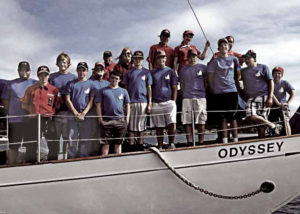
The Odyssey crew.
Why would a Sea Scout Ship need all that space? Why, to store all the gear that comes with two magnificent but needy vessels, the 78’ Charles N. Curtis and the 90’ yawl Odyssey. While professionals are obviously required for structural and critical mechanical work, it’s the Sea Scouts (those 13-21 year-olds) that maintain the yachts. So, not only do those Sea Scouts get the cool factor of going out on these boats, they get the discipline and education of maintaining them as well.
By all accounts, they love both sides of that. I’d be giddy to have someone with that background on my crew.
Odyssey, Sea Scouts Ship 190 in Boy Scout vernacular, is a truly lovely boat with a history. Olin Stephens designed her for the Vanderbilt family, which the Odyssey took racing on Long Island Sound and cruising to such places as Cuba and the Galapagos Islands. In World War II she was used for sonar testing and echo sounding studies. Ultimately, she was sold to the Boy Scouts for $1.
Today, the Odyssey pays her own way largely through charters. Various groups from yacht clubs to corporate types engage the boat, which cruises to the San Juan Islands and beyond. Would there be any better “summer camp” than sailing on Odyssey for a week in the San Juans?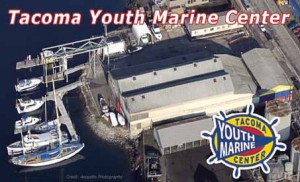
A double whammy hit the mighty Odyssey this past winter. First, her old 1,872 sq ft. main ripped beyond repair in a December storm. Then, her old Detroit 6-71 diesel finally required replacement. And despite getting the replacement John Deere 4045 at cost from Cascade Engine, it was still $23,000. The main costs another $20,000, even with a steep discount from Ullman Sails Pacific Northwest. A sizeable capital fund existed, but not enough to handle two critical emergencies at once. “We’re very pleased the way the public has rallied for us, which is great because we have to be up and running for the charter season,” Russell said.
Fortunately, the Curtis doesn’t have any such major problems currently. Her hull is sound and her twin 6-71s are lovingly cared for and running fine. But in case you think it’s all spiffy and modern, consider that the engine controls are in the engine room, and there’s a telegraph from the bridge to the engine room. The “kids” handle it just fine, thank you very much.
The Curtis’ history is as colorful as Odyssey’s. Built at Southern Shipyards in Newport News, Virginia in 1931, she was designed to chase down rumrunners during prohibition. When Prohibition ended, she came to Tacoma in 1937 as a Coast Guard patrol boat, a duty that extended all the way to the mouth of the Columbia during World War II.
When the Curtis was acquired by the Boy Scouts in 1946, the Sterling Viking II gas engines were traded to the Tacoma fire boat in favor of diesels.
The Curtis is the longest-serving Sea Scout vessel in the country.
While Odyssey and Curtis are the headliners, there are other vessels as well. An inboard-powered former lifeboat functions as a training vessel for the youth and is used to ferry people during waterfront events in Tacoma. The 38’ Vérité is a replica of an 18-century gig, and is another great platform for teaching a rather unique style of sailing.
A separate building provides event space and houses a large classroom, again with eyes toward being a central facility where youth boating organizations from around the region can gather.
The large scope of the TYMC is really a direct result of Tacoma’s (the City of and the Port of) revitalization effort, and in particular its attention to its maritime heritage. Unlike a certain city a bit further north, Tacoma makes genuine concentrated efforts to make its maritime heritage and current maritime activities relevant to a broad spectrum of people.
The reason the TYMC/Commencement Bay Marine Services has such prime real estate is that they lease it on favorable terms. The Port of Tacoma didn’t want to see traditional waterfront activities displaced by rows of condos, but had no interest in operating anything on the land. I’m not sure if they could have found a more appropriate tenant if they tried.
The TYMC has powerful support from a lot of angles. The Board of Directors includes several prominent civic and port officials, in addition to vessel skippers Bud Bronson (Odyssey) and Tom Rogers (Charles N. Curtis).Included among them are Joe Martinac Jr., CEO of Martinac Ship Building, retired Port Commissioner Clare Petrich, plus attorneys, real estate developers and educators.
Despite a blown main and a blown diesel, the future looks bright for the Odyssey, Curtis, the Sea Scouts and the Tacoma Youth Marine Center. Various groups around the region are gradually coming to recognize that ambitious forward thinking, buoyed by a community that recognizes the importance of its waterfront, can do great things.
On behalf of the Odyssey crew, the Youth Marine Foundation in Tacoma is asking for help from the community to get the Odyssey powered up and sailing again. If you can help the “YMF Odyssey Campaign,” call the Youth Marine Foundation, Malcolm Russell at 253-572-2666. Or please visit this website to donate funds: https://fundly.com/ ymf-odyssey-campaign.